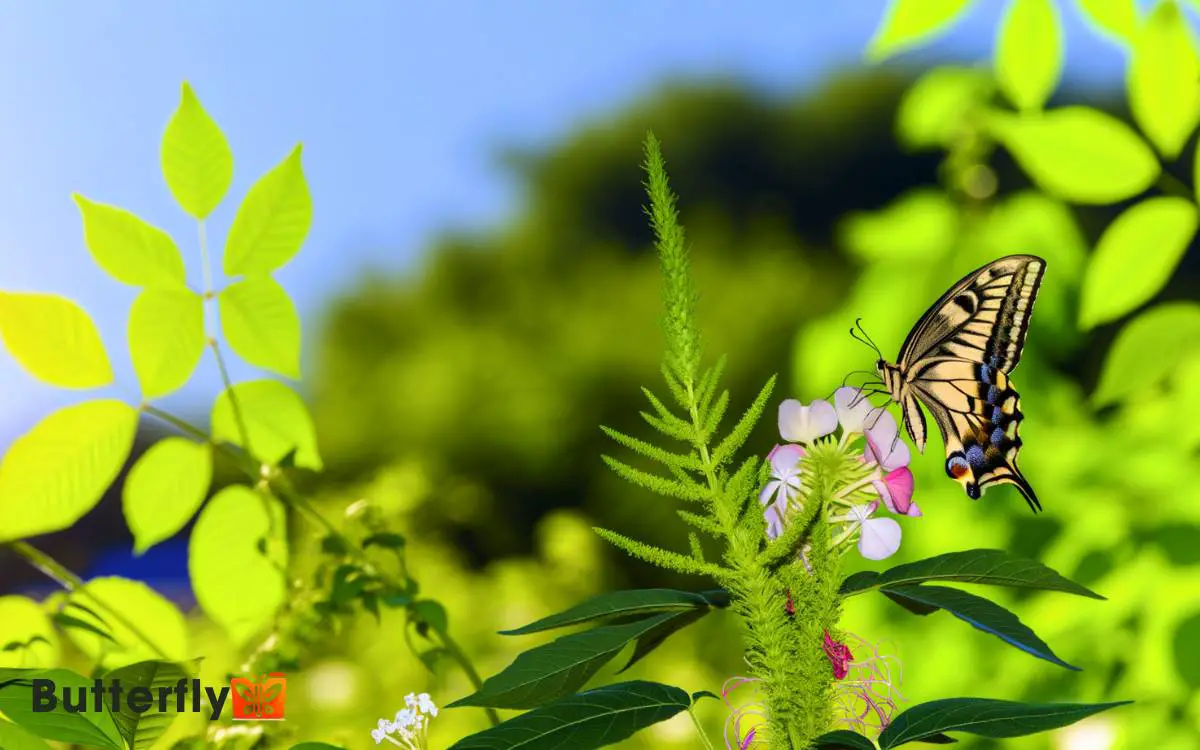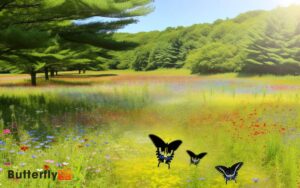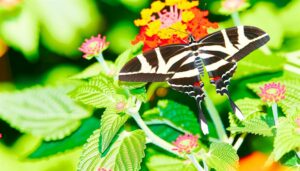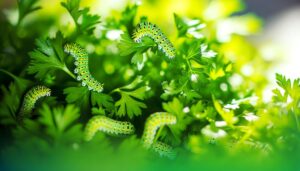How Long Do Swallowtail Butterflies Live? Survival Duration!
Swallowtail butterflies generally live for one to two weeks in their adult stage. Their lifespan is influenced by environmental conditions, such as temperature, humidity, and food availability.
Swallowtails thrive in moderate temperatures and areas with abundant nectar sources. Predation and climate variability also greatly impact their longevity.
Each developmental stage egg, larva, pupa, and adult exhibits unique duration and survival strategies, with adult activities like mating and feeding essential for reproductive success.
Species-specific factors further contribute to lifespan variations, making detailed ecological understanding important. Insights into their life cycle can reveal more about the ecological roles and conservation needs of these butterflies.

Key Takeaways
Swallowtail Butterfly Life Cycle
The life cycle of a swallowtail butterfly consists of four distinct stages: egg, larva (caterpillar), pupa (chrysalis), and adult. Each stage is essential for species propagation.
Initially, eggs are deposited on host plants, ensuring ideal larval nutrition upon hatching. Larvae undergo multiple instars, characterized by significant morphological changes and growth, driven by precise molting cycles.
The pupal stage, or chrysalis, involves extensive metamorphosis, where larval structures are enzymatically broken down and reformed. This transformational phase is crucial for adult morphology.
Egg Stage Duration
Typically, the egg stage duration for swallowtail butterflies ranges from four to ten days, depending on environmental conditions such as temperature and humidity.
Higher temperatures accelerate embryonic development, while lower temperatures prolong it. Best humidity levels guarantee egg viability, preventing desiccation or fungal growth.
Empirical data suggests that eggs exposed to temperatures around 25°C (77°F) hatch more rapidly compared to those at lower temperatures. Field studies have confirmed that eggs laid in shaded, humid environments often have higher survival rates.
The egg’s chorion, a protective outer shell, plays an essential role in safeguarding the developing embryo. Understanding these parameters is vital for conservationists and entomologists aiming to enhance the survival rates of swallowtail populations in varying climates.
Larva (Caterpillar) Stage
During the larva stage, Swallowtail caterpillars undergo significant growth and development, typically increasing their body mass by over 1000%.
They consume host plants such as parsley and dill, engaging in voracious feeding behaviors to store energy for metamorphosis.
The molting process, occurring approximately four to five times, is critical for accommodating their rapid growth and ensuring successful progression to the pupal stage.
Growth and Development
Once the eggs hatch, the larval stage of swallowtail butterflies, known as caterpillars, undergoes a series of molts as they grow and develop. During this period, they progress through five instar stages, each marked by shedding their exoskeleton.
The duration of each instar can vary, typically lasting between 2 to 10 days, influenced by environmental conditions such as temperature and humidity. Morphological changes are evident with each molt, including increased size and color pattern alterations.
It’s essential for them to efficiently utilize this stage for accumulating energy reserves, essential for the pupation phase. The total duration of the larval stage ranges from 10 to 30 days, depending on species-specific developmental rates and ecological variables.
Diet and Feeding
Swallowtail caterpillars primarily consume host plants from the Apiaceae, Rutaceae, and Lauraceae families, leveraging specialized enzymes to digest these frequently toxic plants.
This selective herbivory facilitates ideal nutrient absorption and rapid growth. Research indicates that larvae exhibit a preference for high-nitrogen foliage, enhancing protein synthesis critical for development.
Remarkably, carotenoid intake from these plants contributes to the caterpillar’s distinctive coloration, serving as a deterrent to predators.
Quantitative studies reveal that an average swallowtail caterpillar consumes approximately 200 mg of foliage daily. This voracious feeding behavior underscores the larva’s metabolic demand for energy.
Additionally, larval feeding patterns exhibit diel periodicity, with peak consumption occurring during dawn and dusk, aligning with lower predation risk and optimal moisture levels.
Molting Process
As the caterpillars consume their nutrient-rich host plants, they undergo a series of molts, or ecdysis, necessary for accommodating rapid growth and development.
Each molt involves shedding the exoskeleton and forming a new, larger one. This process is pivotal for the caterpillar to move through its five larval instars.
Key steps in the molting process include:
- Apolysis: The separation of the old cuticle from the epidermis.
- Ecdysis: The shedding of the old cuticle.
- Sclerotization: The hardening and darkening of the new exoskeleton.
Each instar interval varies in duration, typically lasting between 3 to 7 days, accelerating the larva’s development.
Understanding these stages underscores the meticulous design of swallowtail butterfly growth, emphasizing their adaptability and resilience.
Pupa (Chrysalis) Stage
The pupa, or chrysalis stage, is a critical phase in the swallowtail butterfly’s life cycle. It typically lasts between 10 to 20 days, depending on species and environmental conditions. Temperature, humidity, and predation markedly influence the duration and success of metamorphosis.
During this period, substantial physiological transformations occur, shifting the organism from larval to adult form.
Duration of Chrysalis Phase
During the chrysalis phase, Swallowtail butterflies typically remain in their pupal stage for approximately 10 to 20 days, depending on environmental conditions. This period is vital for metamorphosis, where the larval structures are broken down and adult features are formed.
The duration of this stage can be influenced by several factors:
- Temperature: Higher temperatures expedite development, while lower temperatures prolong it.
- Humidity: Ideal humidity levels promote proper physiological processes within the chrysalis.
- Photoperiod: Light exposure can impact hormonal changes crucial for timely emergence.
Throughout this phase, the chrysalis appears inert, yet internally, rapid biochemical and morphological transformations occur.
Understanding the chrysalis duration is essential for those studying Lepidoptera, as it provides insight into developmental timelines and survival strategies.
Environmental Impact Factors
Environmental factors play a significant role in determining the success and duration of the chrysalis stage in Swallowtail butterflies. Temperature, humidity, and photoperiod are critical variables.
Ideal temperature ranges between 20-30°C accelerate metabolic processes, reducing chrysalis duration. Conversely, temperatures below 15°C can extend this phase significantly.
Humidity levels around 70% prevent desiccation, ensuring pupal viability. Photoperiod, the length of daylight exposure, influences hormonal regulation, impacting developmental timelines.
Additionally, pollutants and pesticides present in the environment can induce developmental anomalies or increase mortality rates. Predation by parasitic wasps also poses a threat, reducing the likelihood of successful emergence.
Understanding and managing these environmental parameters is essential for enhancing survival rates during the chrysalis stage in Swallowtail butterflies.
Metamorphosis Process Stages
In the metamorphosis of Swallowtail butterflies, the pupa stage, also known as the chrysalis stage, is essential for the transformation from larva to adult butterfly.
During this stage, significant physiological changes occur, driven by hormonal regulation and genetic reprogramming. The duration of the chrysalis stage varies, typically lasting between 10 to 20 days, depending on environmental conditions.
Key processes in the chrysalis stage include:
- Histolysis: Breakdown of larval tissues.
- Histogenesis: Formation of adult structures.
- Exoskeleton Hardening: Development of a protective outer layer.
These stages are vital for the butterfly’s successful metamorphosis, culminating in the emergence of a fully developed adult capable of reproduction and dispersal.
Understanding these processes highlights the intricacy of lepidopteran development and their adaptability to diverse environmental conditions.
Adult Butterfly Lifespan
Swallowtail butterflies typically have an adult lifespan ranging from a few days to several weeks, depending on species and environmental conditions. The tiger swallowtail butterfly lifespan generally falls within this range, with individuals living around two weeks on average. However, factors such as predation, weather, and availability of food sources can influence their longevity. Some species may extend their lifespan slightly in favorable conditions, especially if they have ample access to nectar-rich flowers.
Factors influencing longevity include temperature, humidity, food availability, and predation pressures.
Ideal conditions, such as moderate temperatures and abundant nectar sources, can extend their lifespan. Conversely, extreme weather, scarcity of food, and increased predation can greatly shorten it.
Adult swallowtails engage in essential activities like mating, oviposition, and feeding on nectar. Their reproductive success and contribution to pollination are closely linked to their lifespan.
By understanding these lifespan determinants, one can appreciate the delicate balance required for their survival.
This knowledge also underscores the importance of habitat preservation for maintaining swallowtail populations and ensuring their ecological roles continue.
Species Variations in Lifespan
Different species of swallowtail butterflies exhibit significant variations in lifespan, influenced by their unique biological and ecological characteristics. These differences stem from genetic factors, metabolic rates, and reproductive strategies.
For instance:
- Papilio machaon: Known as the Old World Swallowtail, typically lives 2-3 weeks.
- Papilio glaucus: The Eastern Tiger Swallowtail’s lifespan ranges from 6-14 days.
- Papilio polyxenes: The Black Swallowtail can live up to 10-12 days.
The longevity of each species is a product of evolutionary adaptations, ensuring survival and reproduction within their respective habitats.
By examining these variations, researchers gain insights into the life history strategies that govern the survival dynamics of swallowtail butterflies. This understanding aids in conservation efforts and informs ecological studies.
Environmental Influences
Beyond genetic factors, environmental conditions profoundly impact the lifespan of swallowtail butterflies, shaping their survival and reproductive success.
Temperature plays a critical role; ideal ranges (20-30°C) enhance metabolic efficiency and prolong life expectancy, while extreme temperatures can cause physiological stress, reducing longevity.
Humidity levels also affect lifespan, with moderate humidity (50-70%) preventing desiccation and promoting hydration. Availability of nectar-rich flora directly influences nutritional intake, essential for energy and reproductive output.
Additionally, habitat fragmentation can limit access to these resources, negatively impacting population viability.
Seasonal variations dictate life cycle stages, with overwintering pupae experiencing diapause to withstand cold conditions, thereby extending their developmental period.
These environmental parameters collectively determine the ecological fitness and longevity of swallowtail butterflies.
Predation and Threats
Consistently, predation and various environmental threats greatly reduce the lifespan of swallowtail butterflies, influencing their population dynamics and survival rates.
Predators such as birds, spiders, and wasps substantially decrease their numbers. Additionally, anthropogenic activities contribute to habitat destruction, further threatening their survival.
Research indicates that only a small percentage of swallowtail butterflies reach maturity due to these factors.
Key threats include:
- Predation: Birds and spiders are primary predators, impacting survival rates to a large extent.
- Parasitoids: Wasps lay eggs in caterpillars, leading to high mortality.
- Habitat Loss: Urbanization and deforestation result in the loss of essential habitats.
These threats underscore the need for conservation measures to guarantee the sustainability of swallowtail butterfly populations.
Impact of Climate
Shifts in climate patterns greatly impact the life cycle and distribution of swallowtail butterflies. Rising temperatures can accelerate metabolic rates, leading to shorter developmental stages but increased mortality.
Data show that higher temperatures may reduce the lifespan of adult butterflies by up to 20%.
Additionally, altered precipitation patterns can affect habitat availability, pushing populations to new, less ideal regions.
Research indicates that erratic weather conditions increase vulnerability to extreme events, like late frosts or heatwaves, which can decimate entire cohorts.
Furthermore, changes in climate can disrupt synchronization between butterflies and their ecological niches, leading to mismatches in emergence timing.
Therefore, climate variability profoundly influences both the survival and geographical range of swallowtail butterflies, posing significant challenges to their conservation.
Role of Host Plants
Host plants play an essential role in the life cycle of swallowtail butterflies, serving as the primary food source for larvae and greatly influencing their survival and development.
The choice of host plant determines larval growth rates, pupation success, and overall fitness. Studies indicate that the availability and quality of host plants directly affect swallowtail populations.
Key aspects include:
- Nutrient Content: High nutrient levels in host plants correlate with increased larval growth and reduced mortality rates.
- Chemical Defenses: Some host plants possess allelochemicals that larvae can sequester, deterring predators.
- Habitat Suitability: The spatial distribution and abundance of host plants impact the butterflies’ reproductive success and dispersal capabilities.
Understanding these factors is vital for predicting population dynamics and ensuring the species’ long-term viability.
Conservation Efforts
Conservation efforts for Swallowtail butterflies primarily focus on habitat restoration initiatives. Addressing threats through targeted mitigation strategies is crucial for their survival.
Enhancing community engagement programs is also a key aspect of these conservation efforts.
Data indicates that habitat loss is a significant factor affecting Swallowtail butterflies. This highlights the importance of implementing precise reforestation and land management practices to protect their habitats.
Community involvement has been shown to increase the success rates of conservation efforts. Educational outreach programs play a vital role in raising public awareness and encouraging participation in conservation activities.
Habitat Restoration Initiatives
Many habitat restoration initiatives aim to preserve the specific ecological conditions essential for the survival of swallowtail butterflies.
These programs focus on enhancing and maintaining diverse habitats that cater to the butterflies’ lifecycle needs, including larval host plants and nectar sources.
Key initiatives include:
- Reforestation Projects: Strategically planting native trees and shrubs to restore degraded habitats.
- Pollinator Gardens: Establishing gardens with a high density of nectar-producing plants to support adult butterflies.
- Wetland Restoration: Revitalizing wetlands to provide essential moisture and microhabitats.
These efforts often involve collaboration between ecologists, local communities, and conservation organizations.
Data indicates that targeted habitat restoration can greatly boost swallowtail population densities, ensuring their long-term viability and ecological balance.
Threats and Mitigation
Swallowtail butterflies face numerous threats, including habitat loss, pesticide exposure, and climate change, necessitating targeted conservation efforts to mitigate these impacts.
Habitat fragmentation reduces breeding grounds, while pesticides contribute to larval mortality rates. Climate change shifts temperature and precipitation patterns, disrupting life cycles.
Effective mitigation strategies involve habitat restoration, organic farming practices, and climate resilience measures. Data indicate that preserving native flora supports larval host plants and adult nectar sources, enhancing survival rates.
Implementing buffer zones around agricultural areas minimizes pesticide drift, reducing exposure. Additionally, climate models guide conservationists in adaptive management, ensuring long-term sustainability.
These scientifically driven interventions are essential for maintaining swallowtail populations, thereby preserving biodiversity and ecological balance in their habitats.
Community Engagement Programs
Engaging local communities in conservation programs greatly enhances efforts to protect swallowtail butterflies by fostering awareness and participation in habitat restoration and sustainable practices.
Data-driven initiatives have shown that community involvement can have a substantial impact on butterfly populations.
By integrating scientific methodologies with grassroots engagement, these programs effectively address conservation challenges.
Key community engagement strategies include:
- Citizen Science Projects: Enlisting volunteers to collect data on butterfly populations and habitats.
- Educational Workshops: Informing residents about sustainable gardening and the importance of native plants.
- Restoration Projects: Mobilizing communities to restore and maintain critical butterfly habitats.
Such initiatives empower individuals while promoting a sense of ownership and responsibility towards local biodiversity. This collaborative approach ensures the long-term sustainability and resilience of swallowtail butterfly populations.
Observing in the Wild
In their natural habitats, precise observation of swallowtail butterflies reveals intricate patterns of behavior and lifecycle stages. Researchers document the temporal distribution of mating, oviposition, and larval development.
Data indicate that adult swallowtails exhibit peak activity during mid-morning to early afternoon, correlating with ideal temperature ranges of 20-30°C. Field studies show that larval host plants greatly influence butterfly distribution and survival rates.
Through mark-recapture techniques, scientists estimate that adult swallowtails’ lifespan ranges from 6 to 14 days, varying by species and environmental conditions.
Habitat fragmentation and climate change impact these patterns, highlighting the importance of conservation efforts.
Detailed field observations provide critical insights into swallowtail ecology, essential for devising effective species management strategies.
Conclusion
To conclude, the life span of swallowtail butterflies, from egg to adult, is intricately dependent on environmental conditions and host plant availability.
The egg stage lasts 4-10 days, followed by a larval stage of 3-4 weeks, a pupal stage ranging from a few weeks to several months, and an adult lifespan of approximately 2-4 weeks.
Like a finely tuned mechanism, each stage is critical, highlighting the importance of conservation efforts to maintain their ecological niche.






